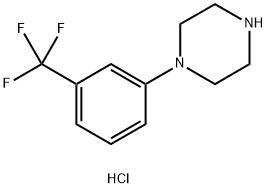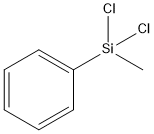1-(3-Trifluoromethylphenyl)piperazine hydrochloride
Synonym(s):3-Trifluoromethylphenylpiperazine hydrochloride;N-[3-(Trifluoromethyl)phenyl]piperazine hydrochloride;TFMPP;TFMPP hydrochloride
- CAS NO.:16015-69-3
- Empirical Formula: C11H14ClF3N2
- Molecular Weight: 266.69
- MDL number: MFCD00039033
- EINECS: 240-153-2
- SAFETY DATA SHEET (SDS)
- Update Date: 2025-01-27 09:38:02

What is 1-(3-Trifluoromethylphenyl)piperazine hydrochloride?
Chemical properties
1-(3-Trifluoromethylphenyl)piperazine hydrochloride is White Solid
The Uses of 1-(3-Trifluoromethylphenyl)piperazine hydrochloride
1-(3-Trifluoromethylphenyl)piperazine hydrochloride used as reference materials for forensic laboratories. They affect the central and the autonomic nervous systems, the blood pressure, and smooth muscle.
General Description
A Snap-N-Spike? reference Solution suitable for use in LC/MS or GC/MS applications for clinical toxicology, forensic analysis, urine drug testing, or pharmaceutical research. 3-Trifluoromethylphenylpiperazine, or TFMPP, is a recreational drug and stimulant sold illicitly under the street name “Legal X.” TFMPP is a structural analog of benzylpiperazine or BZP.
Properties of 1-(3-Trifluoromethylphenyl)piperazine hydrochloride
| Melting point: | 239-241 °C(lit.) |
| Flash point: | 9℃ |
| storage temp. | Refrigerator |
| solubility | methanol:glacial acetic acid (1:1): soluble25mg/mL |
| form | Solid |
| color | White |
| BRN | 8357534 |
| Stability: | Hygroscopic |
| CAS DataBase Reference | 16015-69-3(CAS DataBase Reference) |
Safety information for 1-(3-Trifluoromethylphenyl)piperazine hydrochloride
| Signal word | Danger |
| Pictogram(s) |
 Flame Flammables GHS02  Skull and Crossbones Acute Toxicity GHS06  Exclamation Mark Irritant GHS07  Health Hazard GHS08 |
| GHS Hazard Statements |
H225:Flammable liquids H315:Skin corrosion/irritation H319:Serious eye damage/eye irritation H335:Specific target organ toxicity, single exposure;Respiratory tract irritation H370:Specific target organ toxicity, single exposure |
| Precautionary Statement Codes |
P210:Keep away from heat/sparks/open flames/hot surfaces. — No smoking. P260:Do not breathe dust/fume/gas/mist/vapours/spray. P261:Avoid breathing dust/fume/gas/mist/vapours/spray. P280:Wear protective gloves/protective clothing/eye protection/face protection. P311:Call a POISON CENTER or doctor/physician. P301+P310:IF SWALLOWED: Immediately call a POISON CENTER or doctor/physician. P304+P340:IF INHALED: Remove victim to fresh air and Keep at rest in a position comfortable for breathing. P305+P351+P338:IF IN EYES: Rinse cautiously with water for several minutes. Remove contact lenses, if present and easy to do. Continuerinsing. P405:Store locked up. |
Computed Descriptors for 1-(3-Trifluoromethylphenyl)piperazine hydrochloride
| InChIKey | DGNLGWJZZZOYPT-UHFFFAOYSA-N |
1-(3-Trifluoromethylphenyl)piperazine hydrochloride manufacturer
Cns Chemicals
Hyderabad
Phone:91-9381957258
Whatsapp: 91-9381957258
product: 1-(3-Trifluoromethyl-phenyl)-piperazine hydrochloride
New Products
3-Iodophenylacetic acid 3-Pyridineacetonitrile, α-hydroxy- 2-Propanamine, 1-chloro-, hydrochloride (9CI) 3-(hexyloxy)-4-(pyridin-3-yl)-1,2,5-thiadiazole 2-Hexyn-1-ol Dibenzo-18-crown-6 Nickel(II) perchlorate hexahydrate, 98% 4-Bromophenylacetonitrile, 95% 3-Bromo-4-fluoroaniline, 97% Sodium tetraborate decahydrate, 98% Palladium(II) acetate, trimer, Pd 99% 4-Bromo-2-chlorotoluene, 97% N N Dimethylformamide Dimethyl Acetal (Dmf Dma) 2,3-Dichloro Benzoyl Cyanide [Side Chain] Bis(2-Chloroethyl) Amine Hydrochloride L-Glutamic Acid Diethyl Ester Hydrochloride 5-(Difluoromethoxy)-2-Mercaptobenzimidazole 1-Ethyl-3-(3-Dimethylaminopropyl)-Carbodiimide Hydrochloride [EDC Hcl] 1,4-Napthoquinone Bromoiodomethane Sodium Bicarbonate Methylene Dichloride (MDC) Ethyl Acetate Indole-3-Carbinol (I3C)Related products of tetrahydrofuran




![2-[[(2-ethylphenyl)(2-hydroxyethyl)amino]methyl]-3,3-difluoro-Propanenitrile](https://img.chemicalbook.in/CAS/GIF/2647-14-5.gif)



You may like
-
 3-Trifluoromethylphenylpiperazine hydrochloride solution CAS 16015-69-3View Details
3-Trifluoromethylphenylpiperazine hydrochloride solution CAS 16015-69-3View Details
16015-69-3 -
 17604-74-9 3-Pyridineacetonitrile, α-hydroxy- 98+View Details
17604-74-9 3-Pyridineacetonitrile, α-hydroxy- 98+View Details
17604-74-9 -
 131987-69-4 98+View Details
131987-69-4 98+View Details
131987-69-4 -
 Cyclohexane, (2-propynyloxy)- 67967-07-1 98+View Details
Cyclohexane, (2-propynyloxy)- 67967-07-1 98+View Details
67967-07-1 -
 764-60-3 2-Hexyn-1-ol 98+View Details
764-60-3 2-Hexyn-1-ol 98+View Details
764-60-3 -
 2-Propanamine, 1-chloro-, hydrochloride (9CI) 98+View Details
2-Propanamine, 1-chloro-, hydrochloride (9CI) 98+View Details
5968-21-8 -
 3-Iodophenylacetic acid 1878-69-9 98+View Details
3-Iodophenylacetic acid 1878-69-9 98+View Details
1878-69-9 -
 132945-75-6 (S)-1-Boc-3-methanesulfonyloxy-pyrrolidine 98+View Details
132945-75-6 (S)-1-Boc-3-methanesulfonyloxy-pyrrolidine 98+View Details
132945-75-6
Statement: All products displayed on this website are only used for non medical purposes such as industrial applications or scientific research, and cannot be used for clinical diagnosis or treatment of humans or animals. They are not medicinal or edible.
